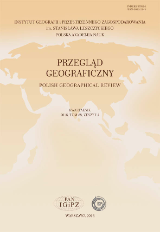Tytuł pozycji:
Klasyfikacja funkcjonalna gmin Polski na potrzeby monitoringu planowania przestrzennego = Functional classification of Poland’s communes (gminas) for the needs of the monitoring of spatial planning
W artykule przedstawiono klasyfikację gmin Polski opracowaną w 2013 r. na potrzeby monitoringu planowania przestrzennego w gminach (Śleszyński i inni, 2015). Wykorzystuje ona metodę dedukcyjno-indukcyjną, wypracowaną pod względem koncepcyjnym i metodologicznym wcześniej dla województwa mazowieckiego (Śleszyński, 2012), a pod względem identyfikacji szczegółowych kryteriów – tzw. typologię funkcjonalną na potrzeby monitoringu planowania przestrzennego w skali lokalnej (Śleszyński i inni, 2007; Komornicki i Śleszyński, 2008). W rezultacie zostało wyróżnionych 10 kategorii (typów) gmin: A – rdzenie Miejskich Obszarów Funkcjonalnych (MOF) ośrodka wojewódzkiego; B – strefy zewnętrzne MOF; C – rdzenie obszarów funkcjonalnych miast subregionalnych; D – ich strefy zewnętrzne; E – miasta-ośrodki wielofunkcyjne; F – gminy z rozwiniętą funkcją transportową; G – gminy o innych rozwiniętych funkcjach pozarolniczych (turystyka oraz funkcje wielkopowierzchniowe, w tym przemysł wydobywczy); H – gminy z intensywnie rozwiniętą funkcją rolniczą; I – gminy z umiarkowanie rozwiniętą funkcją rolniczą; J – gminy ekstensywnie zagospodarowane (funkcje leśne, ochrony przyrody).
24 cm
This article presents a classifi cation of Poland’s administrative areas at the local level: communes (gminas) drawn up in 2013 to monitor spatial planning. This uses the deductive-inductive method, previously developed conceptually and methodological for Mazowieckie voivodship (province-region) (Śleszyński, 2012), as well as (in the identification of detailed criteria), the so-called functional typology for the monitoring of spatial planning (Śleszyński et all., 2007, Komornicki and Śleszyński, 2008). The division of Poland’s communes was based on a classification procedure with four consecutive components (Fig. 1), i.e.: 1) Selection and the establishment of a hierarchy of categories. A deductive hierarchy of factors allowing gminas to be differentiated and assigned to categories is applied, the a priori assumption being categories established at the beginning of the classification procedure are of greater rank and significance than remaining ones. Importance in this case thus relates to a determining factor where spatial organisation is concerned. 2) Selection of criteria typical for the given category. Every category is described on the basis of criteria corresponding to its specific features, e.g. as administrative, economic, etc.; 3) The assigning of gminas on the basis of detailed criteria. Gminas are included in the different categories on the basis of their meeting defined criteria. Moreover, at this stage, exclusion from more distant stages in the classification of gminas already assigned to a category takes place on the highest hierarchical level achievable. 4) Inductive internal differentiation Takes place, with categories of gmina as necessary divided into sub-categories on the basis of hallmark features associated with their individual specificity. This process of assignment to given subcategories entails a search for resemblances arising out of indicators that describe the developmental and morphological features of gminas. This part of the analysis is in the nature of a typical separate classification, entailing the possible division of categories into subcategories by reference to specific features and criteria. The result was the identification of 10 categories (types) of gmina, i.e. A – functional urban areas of voivodship capitals and B – their external zones; C – functional urban areas of subregional centres and D – their external zones; E – multifunctional urban centres; F – gminas with developed transport functions; G – gminas with other developed non-agricultural functions (tourism and large-scale functions, including mining); H – gminas with intensively developed agricultural functions; I – gminas of moderately developed agricultural functions; J – extensively developed gminas (with forests and nature protection areas). The specific use of the classification is associated with an evaluation of those phenomena and processes whose characteristic feature is diversity in terms of function. On the basis of this classification it is possible to study types of development direction in gminas, as well as intensities of demographic, social, economic and other processes ongoing in them. This may allow for the identification of regularities impossible or difficult to observe by reference to the traditional administrative divisions.
